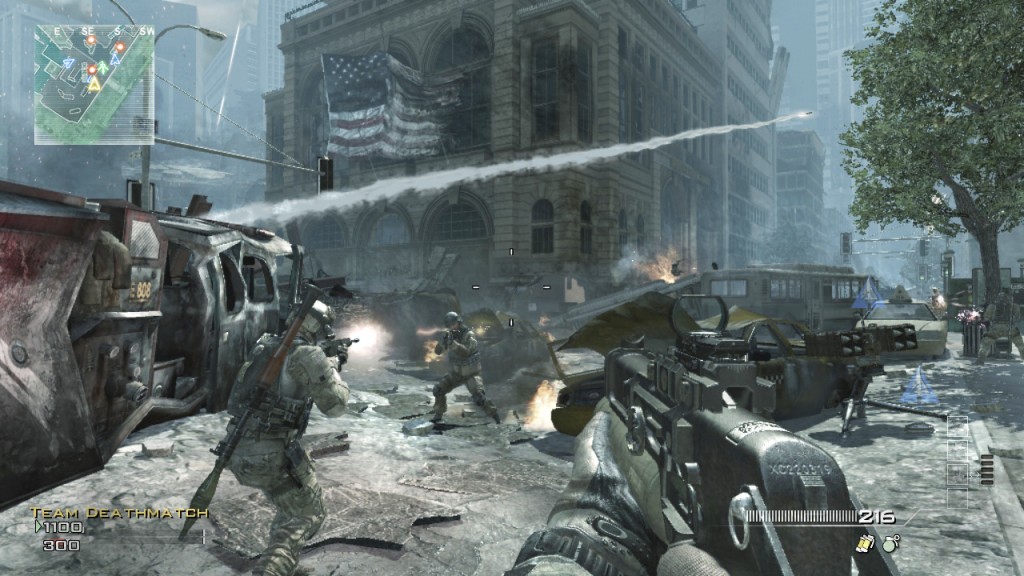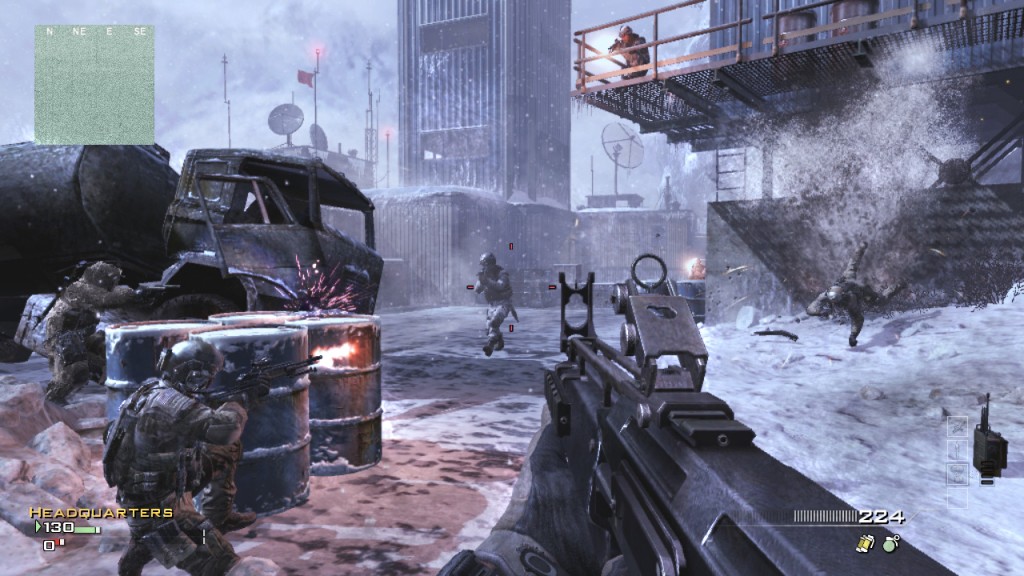Call of Duty: Well Developed or Well Marketed?
 Call of Duty is a gaming powerhouse. An instantly recognized name that attracts millions of gamers with every release, earning accolades from players and critics alike. It’s arguably the most well-known franchise on the market today, able to attract and keep a diverse and dedicated fanbase.
Call of Duty is a gaming powerhouse. An instantly recognized name that attracts millions of gamers with every release, earning accolades from players and critics alike. It’s arguably the most well-known franchise on the market today, able to attract and keep a diverse and dedicated fanbase.
But is it really as good as all that? Call of Duty, despite its mammoth popularity, is a franchise that has offered little to the industry as a whole. Though its sales figures are enviable, other first-person shooters surpass it in terms of gameplay variability, technological progression, and storytelling ability. Call of Duty is, at its core, a ten-year-old game wrapped in a modern package.
What has Call of Duty ever done? The hallmark of the single-player – the admittedly intense and well-scripted set-piece action sequences – was pioneered by the Medal of Honor series (which is where many of Infinity Ward’s key developers came from in the first place) and brought to cinematic perfection in Gearbox’s Brothers in Arms series. Other first-person shooters have easily surpassed it in terms of storytelling sophistication, even after World War II games began to lose popularity. Aside from its storytelling, Call of Duty also indicates its age in other ways, for example, the death animations are still primarily animations, meaning that Call of Duty hasn’t even fully embraced ragdoll physics.
In fact, it goes far beyond that; there is almost no physics-based gameplay apparent at all. No bullet drop over long distances, no ricochet, no collapsible walls or other destructible environments – nothing at all that would indicate Call of Duty is a game made in the 21st Century. It has always been this way, but it’s only becoming obvious now that so many other shooters are coming out armed with a variety of creative gameplay additions. The destructible environments in the last couple of Battlefield entries are not only visually impressive – the impact of passing through battle-scarred towns and seeing gutted houses, blown out walls and entirely collapsed buildings will not be easily topped – but they also fundamentally alter the way the player approaches every combat situation.
Not so in Call of Duty; walls, cars, and sometimes even tarps and doors are so bulletproof that shooting at them barely leaves scratches and dings, let alone giving the player the ability to bust them down and find an alternate path through the level. The single-player banks on this and funnels the player through a variety of stupidly challenging situations, like forcing a player to walk through the front door of a house covered by two machine guns while several soldiers on a landing chuck grenades through the door. After dying and trying the same thing about 12 times, it becomes apparent that not only was it supposed to happen this way, but that none of your tools work. Smoke grenades only seem to obscure your vision, and the machine guns and grenades still track through the smoke directly into your face. Walls, tarps and shipping boxes never even seem to give the player any type of concealment; the moment you step out from behind any of these objects, the bad guys magically twist around and fire within milliseconds, managing to hit you even though the animation hasn’t caught up with the action as yet. The silly visual image of seeing a bullet come at you before the enemy has even completed his turn – or even pointed his gun at you – is mind-blowingly frustrating.
While a player who’s gone through Half-Life 2 can exploit the scripting of that game, it takes some experience to know where and when those exploits can happen. In Call of Duty, it doesn’t seem like they care. The scripting is so obvious that it’s easy to tell where the trigger points are for the endlessly respawning enemies that come at you in ludicrous waves, following the same path in the same way with the same numbers every single time (the firefight under the derelict Ferris wheel in Call of Duty 4 comes to mind) until a specific objective is completed or an invisible line is crossed. Other games count on the same scripting, of course, but the ability for the player to actually affect their own path through the level helps considerably to make it less noticeable.
However, Call of Duty hasn’t focused on its single player in quite a while, at least not since before Call of Duty 4. I doubt anyone out there waits in line to go out and see how the GI Joes of Western Europe and the United States can triumph once more over the evil, evil terrorists, and the way the game is marketed seems to indicate that Infinity Ward, Treyarch, Sledgehammer Games and whatever other studio has helped to develop any of the recent titles focus mostly on the multiplayer element as well. It largely has the same problems as the single player – scripted death animations, bulletproof concealment, indestructible environments, and no bullet physics over long distances.
 None of that seems to matter though, since Call of Duty’s biggest, most worrisome trend is to cover all of the shoddiness and old-fashioned gameplay with shiny graphics and addictive, but superficial, RPG elements. The trick to Call of Duty’s success isn’t that it’s well designed; it’s that it has taken elements from other games that have proven addictive and duct-taped them into place to keep players interested.
None of that seems to matter though, since Call of Duty’s biggest, most worrisome trend is to cover all of the shoddiness and old-fashioned gameplay with shiny graphics and addictive, but superficial, RPG elements. The trick to Call of Duty’s success isn’t that it’s well designed; it’s that it has taken elements from other games that have proven addictive and duct-taped them into place to keep players interested.
Take a moment and think about Farmville. Farmville is a game designed to keep people coming back by providing false rewards and false punishments. You let your crops fail and you lose money; but if you maintain them – if you come back every twenty minutes to make sure they’re watered, to make sure they’re growing (and maybe take a peek at Farmville’s sponsors while you’re at it) – then you get to earn some fake money, which you can spend on building new buildings or buying new equipment. New equipment to help you farm. So you can earn more fake money. By growing non-existent crops.
What exactly do these two games have in common? Call of Duty uses the same principles; instead of giving you fake money to spend on fake farm equipment, it gives you access to arguably more powerful weapons, more convoluted (and usually broken until the second or third patch) loadouts, and new skins. It keeps you focused not on the game itself, but the little ticker at the bottom of the screen that goes up every time you kill someone. In a game that is designed to give you a few kills every 30 seconds or so, that ticker goes up a lot. And what happens after you unlock all there is to unlock? When you’ve designed a loadout that works for you (or, more likely, you’ve unlocked the perks and weapon sets that the Internet has told you is the most effective for getting a huge number of kills and few deaths), the game continues giving you false rewards. Already have the highest skill level on the AR-15? Well, why don’t you just Prestige Class it? That way, you’ll never be without a counter ticking up and up and up while you play. I imagine most Call of Duty fans would vehemently deny that this is why they play. They’d shout, wave their arms and try desperately to come up with legitimate reasons why they keep coming back to it more than Halo or Battlefield because they think they’re too smart or too experienced to be pulled in by such a stupidly obvious ploy.
Of course, everyone wants to believe that. No one wants to believe that they’ve spent $60 once or twice a year for Farmville: Down With Terr’ism, and that they’ve been the victim of one of the most diabolically impressive marketing campaigns of all time.
 Despite the fact that Call of Duty has introduced nothing new to multiplayer shooters and that it hasn’t had a coherent story since Call of Duty 2, it continues to sell in record numbers. Although each new game – released once a year like clockwork – is little more than a $60 graphical facelift and multiplayer patch (one which, ironically, introduces a few more balance issues, bugs, and exploits than the previous one) the game continues to fly off the shelves and even earn some critical acclaim.
Despite the fact that Call of Duty has introduced nothing new to multiplayer shooters and that it hasn’t had a coherent story since Call of Duty 2, it continues to sell in record numbers. Although each new game – released once a year like clockwork – is little more than a $60 graphical facelift and multiplayer patch (one which, ironically, introduces a few more balance issues, bugs, and exploits than the previous one) the game continues to fly off the shelves and even earn some critical acclaim.
All of that is owed almost entirely to its marketing department. Imagine that everything I’ve said so far is true, that whatever company primarily developing that game at whatever point in its history cares nothing for making games, and gaming in general, better, but is simply releasing a slightly modified version of their old game. This means that the developers are only paying for a slight graphical improvement, a new 4.5 hour chest-thumping, manly-man story, and the maps and scripting for the single player and multiplayer maps. Considering that they won’t have to design a new engine or implement any kind of new technology into their engine at all, they’re essentially releasing stand-alone expansions that should cost maybe $30 or $40 instead of $60. But when you see the commercials airing during the NBA playoffs and the NFL Superbowl, with celebrities in live-action ads that air about twelve times for every one of their competitors, it makes more sense.
The marketing all adds up to carve out a niche for Call of Duty as the only logical choice for a modern shooter. It represents itself as self-evidently the most modern, most impressive, most thoroughly-acclaimed game in history. Look at the most recent campaign for MW3 – it calls itself “the most anticipated game of 2011,” a claim as spurious as it is impossible to disprove. People play it not because it is a quality game, but because they believe, at some base and possibly subconscious level, that it really is the most anticipated game of all time, that everyone’s playing it and they don’t want to miss the boat. And before everyone starts getting all defensive about it, remember that this is how marketing is supposed to work. We’re supposed to think that the conclusion we came to is one of our own volition, instead of the effect of propaganda and advertising.
The fact is Call of Duty has had more than its time in the spotlight. It’s 2012, and if we believe the idiots who misread the Mayan calendar, it’s the last year of all time. I’d say, in light of our pending destruction as a species, we need to leave a gaming legacy that’s more than decade-old elements wrapped in shiny graphics and marketed by people who are arguably more talented and driven than the rest of the development team combined.
I’ve had enough, and I think it’s time everyone else has had enough as well. Let Call of Duty know that we’re not going to take this any more, that we want a developer with the kind of following and the kind of capital that Call of Duty has given them, that they’re the studios who need to start making risky decisions, embracing new technologies and new innovations, and trying things that have never been tried before, instead of sitting back and counting their money like Scrooge McDuck. The longer we let games and franchises like Call of Duty flourish, the longer we’re going to be stuck playing the same games over and over, as if we’ve all collectively decided that the fifth ring of Dante’s Hell is good enough for us, as long as we can triple-prestige with our M4. Go play some indie games. Try something new. Look at the hundreds of free games developed with the Unity engine and tell me that Call of Duty is on the cutting edge of anything but graphics. The industry is better than that, and it’s time we start realizing it.
Stop giving Call of Duty the power to dictate our future.
About This Post

